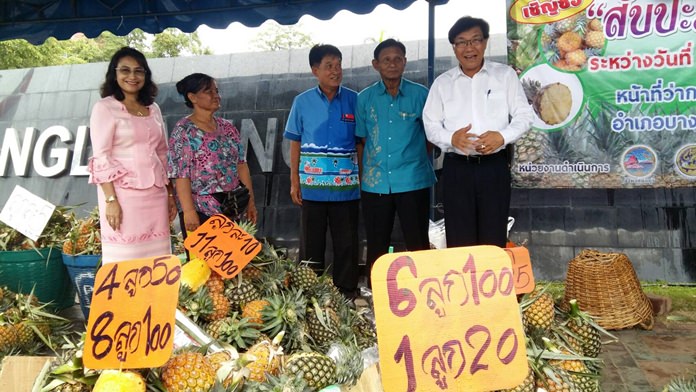
With pineapple farmers resorting to giving away their crops rather than watching them rot, Chonburi has stepped up efforts to get Thais to buy the excess fruit.
 Deputy Gov. Chaichan Iamcharoen revived a campaign to promote sales of Sriracha pineapples, a popular variety rich in juice and meat grown in Chonburi and Rayong. A similar campaign was run last year.
Deputy Gov. Chaichan Iamcharoen revived a campaign to promote sales of Sriracha pineapples, a popular variety rich in juice and meat grown in Chonburi and Rayong. A similar campaign was run last year.
Pineapple farmers nationwide have become desperate as prices for the country’s signature fruit have plummeted due to oversupply. Factories paid an average of just. 3.1 baht per kilogram in the first five months of this year, half of 2017’s rate. Retail prices have gone from an average 12.3 baht to 3.1 baht as well, according to the Office of Agricultural Economics.
As a result, farmers have been unable to sell their crops, leading many to donate them to animal farms or drop them in the jungle for wild animals.
Rayong and Chonburi are the fourth- and fifth-largest pineapple-growing provinces in the country, respectively.
Chaichan said the promotional effort aims to help farmers in Banglamung, Sattahip, Sriracha, Nongyai, Ban Bung, Sattahip, Phanat Nikhom, Koh Chan and Bo Thong districts where 23,580 rai are covered in pineapple, yielding up to 144,734 tons of pineapple.
Local governments also continue to push hotels, restaurants and other local sources to buy more pineapple, even though 90 percent of the country’s crop is grown for export.
Prime Minister Prayut Chan-o-cha last month blamed farmers for their plight, saying too many growers respond to temporary price hikes by massively increasing their output, leading to gluts and price crashes.
He ordered the Commerce, Industry and Agriculture ministries to come up with a coordinated plan for all crops to plan sustainable levels of growing.





